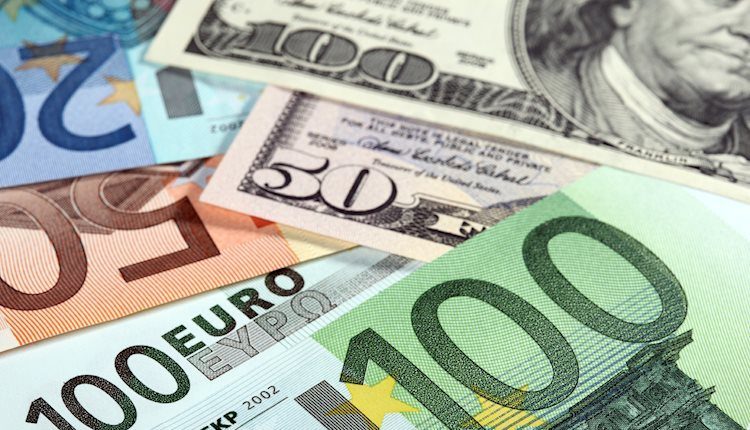- The Euro maintains the narrow range against the US Dollar.
- European stocks trade mostly with gains on Friday.
- Markets’ attention will be on the US inflation tracked by the PCE Price Index.
The Euro (EUR) appears fragile against the US Dollar (USD) on Friday, prompting EUR/USD to trade within a tight range around the mid-1.0500s at the end of the week.
The Greenback manages to keep the trade in the upper end of the weekly range near 106.70 when measured by the USD Index (DXY). The tepid advance in the Dollar comes in tandem with an equally lacklustre uptick in US yields across different time frames.
In the realm of monetary policy, a growing consensus has formed amongst market participants that the Federal Reserve (Fed) will preserve its present stance of retaining interest rates unchanged at the meeting on November 1. The door remains open, however, to a potential rate hike in December, a view that appears well propped up by the resilience of the US economy and still elevated inflation.
Back to the European Central Bank (ECB), there were no surprises at its event on Thursday following a unanimous hold. President Christine Lagarde reiterated once again that there is still job to be done regarding inflation, while it is expected that inflation will remain too high for too long. Adding a bearish tone to the meeting, Lagarde acknowledged that risks to the eocnomic outlook appear tilted to the downside.
On the domestic calendar, the ECB released its Survey of Professional Forecasters (SPF) and now sees inflation tracked by HICP at 2.7% in 2024 and 2.1% in 2025. Regarding economic growh, the survey sees readl GDP growth at 0.9% and 1.5% for the next year and 2025, respectively.
In the US, the salient event will be the publication of inflation figures tracked by the Personal Consumption Expenditures (PCE) Price Index and Core PCE for September, followed by Personal Income, Personal Spending and the final readings for October of the Michigan Consumer Sentiment Index.
Daily digest market movers: Euro looks cautious ahead of key US data
- The EUR maintains a slightly offered bias against the USD on Friday.
- US and German yields attempt a mild bounce.
- The Fed could still hike rates by 25 basis points in December.
- Investors continue to digest the ECB’s decision to leave borrowing costs unchanged.
- Fears of an extension of the Middle East crisis appear to be on the rise.
- The possibility of FX intervention keeps gyrating around USD/JPY.
- Consumer Confidence in France ticked higher to 84 in October.
- ECB’s SPF sees inflation in the region at 2.1% in 2025.
- US PCE figures take the centre stage across the pond on Friday.
Technical Analysis: Upside bias in the Euro appears capped around 1.0700
EUR/USD remains stuck around 1.0550 amidst a persistent selling bias.
If the selling trend continues, immediate support might be found at the October 13 low of 1.0495, followed by the October 3 low of 1.0448 before reaching the round level of 1.0400. If this zone is breached, the pair may continue to decline towards the November 30, 2022 low of 1.0290 and the 2022 low of 1.0222 recorded on November 21.
If bulls reclaim control, EUR/USD will face first resistance at the October 24 high of 1.0694, which appears to be supported by the proximity of the temporary 55-day Simple Moving Average (SMA). The breakout of this zone exposes the high of 1.0767 on September 12, which precedes the key 200-day SMA at 1.0812. Once this level is surpassed, it may imply a further push for the August 30 height of 1.0945, prior hitting the psychological 1.1000 mark. If the upward trend continues, the August 10 record of 1.1064 may be challenged, followed by the July 27 high of 1.1149, and potentially even the July 18 peak of 1.1275.
As long as the EUR/USD remains below the 200-day SMA, the pair may remain under pressure.
ECB FAQs
The European Central Bank (ECB) in Frankfurt, Germany, is the reserve bank for the Eurozone. The ECB sets interest rates and manages monetary policy for the region.
The ECB primary mandate is to maintain price stability, which means keeping inflation at around 2%. Its primary tool for achieving this is by raising or lowering interest rates. Relatively high interest rates will usually result in a stronger Euro and vice versa.
The ECB Governing Council makes monetary policy decisions at meetings held eight times a year. Decisions are made by heads of the Eurozone national banks and six permanent members, including the President of the ECB, Christine Lagarde.
In extreme situations, the European Central Bank can enact a policy tool called Quantitative Easing. QE is the process by which the ECB prints Euros and uses them to buy assets – usually government or corporate bonds – from banks and other financial institutions. QE usually results in a weaker Euro.
QE is a last resort when simply lowering interest rates is unlikely to achieve the objective of price stability. The ECB used it during the Great Financial Crisis in 2009-11, in 2015 when inflation remained stubbornly low, as well as during the covid pandemic.
Quantitative tightening (QT) is the reverse of QE. It is undertaken after QE when an economic recovery is underway and inflation starts rising. Whilst in QE the European Central Bank (ECB) purchases government and corporate bonds from financial institutions to provide them with liquidity, in QT the ECB stops buying more bonds, and stops reinvesting the principal maturing on the bonds it already holds. It is usually positive (or bullish) for the Euro.
Read the full article here

